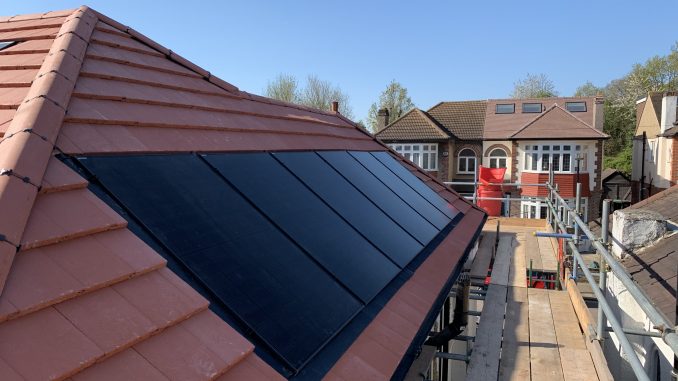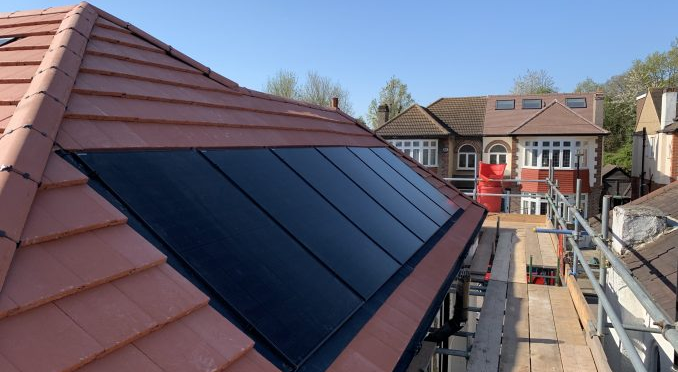
Installing a sustainable roof can help to significantly reduce your household carbon footprint.
These eco-friendly roofs reduce energy consumption, helping homes cut their electricity bills while increasing comfort levels and saving the environment.
This article will look at how solar roofing tiles, high-quality insulation, and a living roof can help minimise your monthly electricity bills and environmental impact.
Invest in Solar Roofing Tiles for a Greener Future
There are many benefits of investing in solar roofing tiles, including:
- Long-term investment: Despite the initial upfront costs, installing solar panels helps households reduce their monthly energy usage and utility bills. As a result, households can save money in the long run.
- Eco-friendly: PV solar tiles are also eco-friendly and generate solar electricity using the sun. Solar roof panels reduce reliance on fossil fuels for heating, lighting, and powering electronic appliances.
- Enhanced property value: Potential buyers are willing to pay more for homes and businesses with solar panels. Buildings with these systems indicate a commitment to sustainability, making them desirable for eco-friendly consumers.
- Durable: Solar panel systems last decades and can withstand long periods of sunshine, rain, and snow, making it a valuable, long-term investment.
- Minimal maintenance: While they require periodic cleaning and routine inspections, solar tiles require little upkeep.
- Enhances your home’s curb appeal and aesthetics: Made from high-quality materials, solar roof tiles boast sleek designs and seamlessly blend into your home’s architecture.
- Opportunity to store generated energy: Many roof-integrated solar panels come with batteries that store excess energy. This stored energy can be used during the night or times of high electricity needs.
The Benefits of Insulated Roof Systems for Maximising Energy Efficiency
To further enhance household energy efficiency, owners should also ensure their roofs are insulated. Proper insulation under your roof covering has the following advantages:
- Reduces energy losses: An insulated roof helps prevent heat and energy losses during winter, keeping your home warmer. Additionally, it can help keep your home cool during the summer – it’s a win-win situation!
- Reduces electricity usage: Insulation reduces draughts and the energy needed to continually cool or heat living spaces.
- Enhances structural integrity: High-quality insulation can strengthen your existing roof structure, helping ensure your family’s safety.
The Practicalities of a Living Green Roof
Another excellent choice is opting for a living green roof. These roofs, where living plants and vegetation are used as a covering, have the following benefits:
- Helps regulate household temperatures. These natural roofs serve as excellent insulators and help regulate indoor temperatures more efficiently. Keeping temperatures constant during cold and warm months, living roofs reduce the energy needed for heating and cooling.
- Improves air quality. Plants in living roofs help remove carbon dioxide and other pollutants from the atmosphere, ensuring cleaner, healthier air, especially in urban areas prone to air pollution.
- Aids in stormwater management. Living roofs absorb rainwater, helping reduce runoff and flooding risks. The plants also retain water, reducing the need to water them and helping decrease water consumption in homes.
- Enhances biodiversity. These eco-friendly roofs create natural habitats for other plants, insects, birds, and microorganisms, boosting the biodiversity of urban areas.
- Aids in noise reduction. The soil, plants, and trapped air on living roofs help absorb external noises, providing a layer of sound insulation and reducing ambient noise around homes.
- Aesthetic appeal. Living roofs can enhance the attractiveness of your home. They help create a lush and appealing home exterior. As a result, they can possibly increase your home’s value, too.
Maintaining Your Durable Roof: Tips for Longevity and Efficiency
Use the following tips to keep your roof in tip-top condition, helping extend its lifetime and energy efficiency:
- Remove debris: Regularly clean your roof, gutters, and solar panel roof tiles. By removing dirt, leaves, and other buildup, you reduce the risk of mould that can cause rot and structural damage.
- Inspect every roof and solar tile: Check that all solar shingles and tiles sit flat against the roof’s surface. Promptly replace cracked, bent, or missing tiles or shingles.
- Inspect chimneys, skylights, and vent openings: Check for cracks or openings that can let in water, leading to leakages and structural damage. Ensure that all openings are sealed with water-resistant sealant.
- Consult a professional. Arrange for a professional, annual roofing inspection. A trained specialist can guide you on repairs and help you keep your roof in tip-top condition.
Final Thoughts
Whether installing traditional solar panels, high-quality insulation, or a living roof, you can do your part for the environment and reduce energy consumption.
Regularly inspect and maintain your eco-friendly roof to ensure it lasts for years and keeps your home energy efficient.

